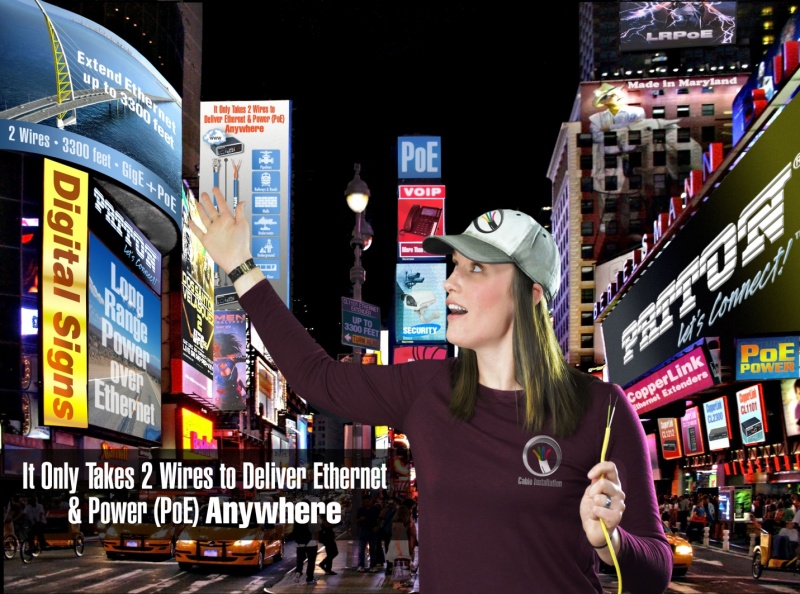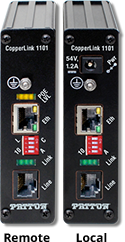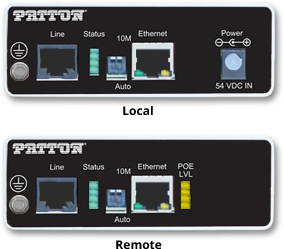Digital Signage Revolution: How Power over Ethernet Changes the Game
 Does it seem to you that just about every area of life is heading toward digital technology? At least one particular market, computer-driven electronic signs—a.k.a. digital signage—seems to fall squarely into that trend.
Does it seem to you that just about every area of life is heading toward digital technology? At least one particular market, computer-driven electronic signs—a.k.a. digital signage—seems to fall squarely into that trend.
Writing for SKYKIT, Irfan Khan [1], predicted: “Rather than an afterthought or a separate effort, [digital signage is] going to become more deeply linked to all aspects of connecting with and serving customers…and linked up to social media. This [growth] will be aided by emerging and increasingly widely available tech like high-resolution LCD and LED screens.”
In nearly every business sector today, including transportation and industrial applications, digital signage has become a driver as well as a consequence of the digital revolution.
With good reason. The technology offers some powerful advantages:
- Sizzle! Eye-catching, engaging—even animated—visual appeal.
- Eliminate recurring expenses for updating, printing, and distributing traditional signs, placards, menus, billboards, etc.
- Revise and update on-screen messages by the second including advertiser rotation.
- Automate varied messaging by time-of-day, day-of-week, outdoor temperature, or whatever parameter suits your fancy!
- Advertisers can instantly improve the relevance of their campaign program (e.g. a local news broadcaster could swap in a promotion for the top story in the upcoming evening show).
Single-Pair PoE Solution Extends Reach for Remote Devices
What about restaurants, for example? According to Digital SignageToday fast-food chains typically experience a 10 to 50% boost in sales after installing digital menu boards. [2] Among quick service restaurants (QSRs) studied, 11% achieved payback on their investment within 6 months and another 30% within 12 months.
In 2013, ViewSonic.com predicted the use of small-screen digital displays would grow exponentially in following years. [3] What do you think? Were they were right? Is there a downside?
Clearly, by delivering visually compelling messages, easily updated in real time, digital signage solutions are faster, more cost-effective, and greener than traditional static signage options.
In retail environments, small-screen display panels can position promotions and product highlights directly in front of customers at the exact location where they are examining a product. A digital photo frame, for example, on a retail shelf or counter, might work as an ideal special-offer or product-information presentation solution.
In factories and other workplaces, digital display screens can provide easily-revised, up-to-date work instructions, safety regulations, and company announcements. The list of potential benefits and possible applications for digital signage displays goes on and on.
What About the Downside?
As with most new technologies, implementing new digital signage comes with a few challenges, which are liable to create roadblocks to certain would-be users:
Cost…
Would you believe the price tag for the actual digital sign is likely to be the smallest item on the project budget sheet? Often higher-cost budget items for the project include the business disruption (lost revenue) and expenses associated with purchasing and installing CAT5e (or similar) digital communication cabling. To deliver requisite electrical power to the desired signage location, AC power construction may be required: opening walls, digging into pavement, running the wiring, installing power connections, and then cleaning up the mess. These are non-trivial budgetary line items.
Distance…
Typically, digital-signage device control and content delivery is centrally managed with a back-office computer that delivers audiovisual content using High-Definition Multimedia Interface (HDMI), which is based on the EIA/CEA-861 standard. (HDMI-over-IP has essentially replaced the older analog video standards in digital signage scenarios). In many applications (notably outdoor and campus environments), the optimal position for the digital sign is located far beyond the 300 feet (100 meter) reach of standard Ethernet—the de-facto network protocol for modern digital communication. In addition electrical power may not be readily available where the digital sign is actually wanted.
Infrastructure…
Many project sites lack sufficient installed infrastructure to support IP-network communications between the display panel and the computer that manages and controls it. The same may also be true or supporting electrical wiring to and power outlets at the display screen location. As noted above, either or both of these infrastructure limitations, has the potential to kill the viability of the project with respect to budget and return on investment (ROI).
Power-over-Ethernet to the Rescue!
Were you wondering when we would we get to the “game changer” part? The advances embodied in Power-over-Ethernet (PoE)—when combined with PoE extension technology—enable system designers to create solutions that address all three challenges presented above.
The CopperLink PoE Ethernet Extender kits from Patton Electronics offer the capability to power up and connect remote PoE-enabled digital signage using common copper twisted-pair phone wire or coaxial cable. This network infrastructure is ubiquitous: most sites already have previously-installed twisted pair or coaxial cabling in place. Much of it was installed decades ago and still works just fine.
 Available in commercial-desktop (CL1101) and hardened-industrial (CL1101E) enclosures, Patton’s PoE Ethernet Extender kits can extend Ethernet connectivity up to 3,300 feet (far beyond 328 feet limit for standard Ethernet) while delivering up 15 watts of electrical power to PoE endpoint devices—all transmitted across existing common copper phone wire.
Available in commercial-desktop (CL1101) and hardened-industrial (CL1101E) enclosures, Patton’s PoE Ethernet Extender kits can extend Ethernet connectivity up to 3,300 feet (far beyond 328 feet limit for standard Ethernet) while delivering up 15 watts of electrical power to PoE endpoint devices—all transmitted across existing common copper phone wire.
These solutions eliminate any need for construction projects to install network cabling, electrical service wiring, or power outlets. Even high-quality outdoor Cat 5 is more affordable than USB repeaters or AC wire. CL1101 devices can also operate over Cat 3, Cat 5/5e, or Cat 6 cabling.
Whereas standard PoE specifies a 4-wire requirement, the CL1101 can operate over a single twisted pair (2 wires) to deliver Power-over-Ethernet and Ethernet/IP traffic over distances up to 3,300 feet (915 meters).
Further, when using 24-AWG twisted-pair cabling, these units can leverage multiple wire pairs, bonding 2, 4 or 8 twisted pairs into a single channel to fully-optimize achievable speed and distance for each environment.
The remote unit in these kits does not require a local power source. Even so, it provides up to 15 watts of PoE power to the remotely connected digital sign (or other PoE enabled device). The solution uses network bridging technology to transmit Ethernet LAN traffic transparently to all higher-layer protocols.
Because the Patton PoE solution leverages low-voltage copper twisted-pair wiring to deliver power to PoE screen panels, the high costs of contracting and licensing a high-voltage cabling project are entirely avoided. Twisted pair—which is found nearly everywhere—is all that is required to fully power and communicate with digital signage.

Digital Signage Application using the CL1101 PoE Extender Kit
Compatible Digital Signage Products
The CL1101 and CL1101E are compatible with the following digital signage products among many others:
- Samsung DB10E-POE
- ViewSonic EP1031R
- IAdea XDS-1068
- Mimo MCT-10QDS-POE
- LG 10SM3TB
Ease of Use
 Finally, the CopperLink 1101 PoE Ethernet Extender solutions feature fast and convenient installation with plug-and-play set-up and operation. When combined with PoE extension technology, PoE allows you to create affordable digital display panel solutions, with nearly negligible installation costs. Now, with CL1101 kits from Patton, businesses can deploy PoE anywhere without concern for local AC power standards, outlets, plugs, or reliability.
Finally, the CopperLink 1101 PoE Ethernet Extender solutions feature fast and convenient installation with plug-and-play set-up and operation. When combined with PoE extension technology, PoE allows you to create affordable digital display panel solutions, with nearly negligible installation costs. Now, with CL1101 kits from Patton, businesses can deploy PoE anywhere without concern for local AC power standards, outlets, plugs, or reliability.
Because the Patton PoE solution leverages low-voltage copper twisted-pair wiring to deliver power to PoE screen panels, the high costs of contracting and licensing a high-voltage cabling project are entirely avoided. Twisted pair, which is found nearly everywhere, is all that is required to fully power and communicate with digital signage.
Conclusion
In virtually every market sector, with the advantages described above, Power-over-Ethernet Extension solutions can enable businesses everywhere to eliminate costly electrical and network cabling construction when deploying remotely-controlled digital display screens.
So what do you think? Will PoE Ethernet extender technology turn out to be a game-changer for mass adoption of digital signage?
For more information about the CopperLink PoE extension solutions go to www.patton.com/cl1101
References:
[1] https://www.skykit.com/blog/digital-signage-trends/
[2] https://www.digitalsignagetoday.com/blogs/digital-menu-boards-overhyped-or-beneficial
[3] http://www.viewsonic.com/us/news/post/view/id/2906
Originally written by Glendon Flowers and published by Patton, view original post.







